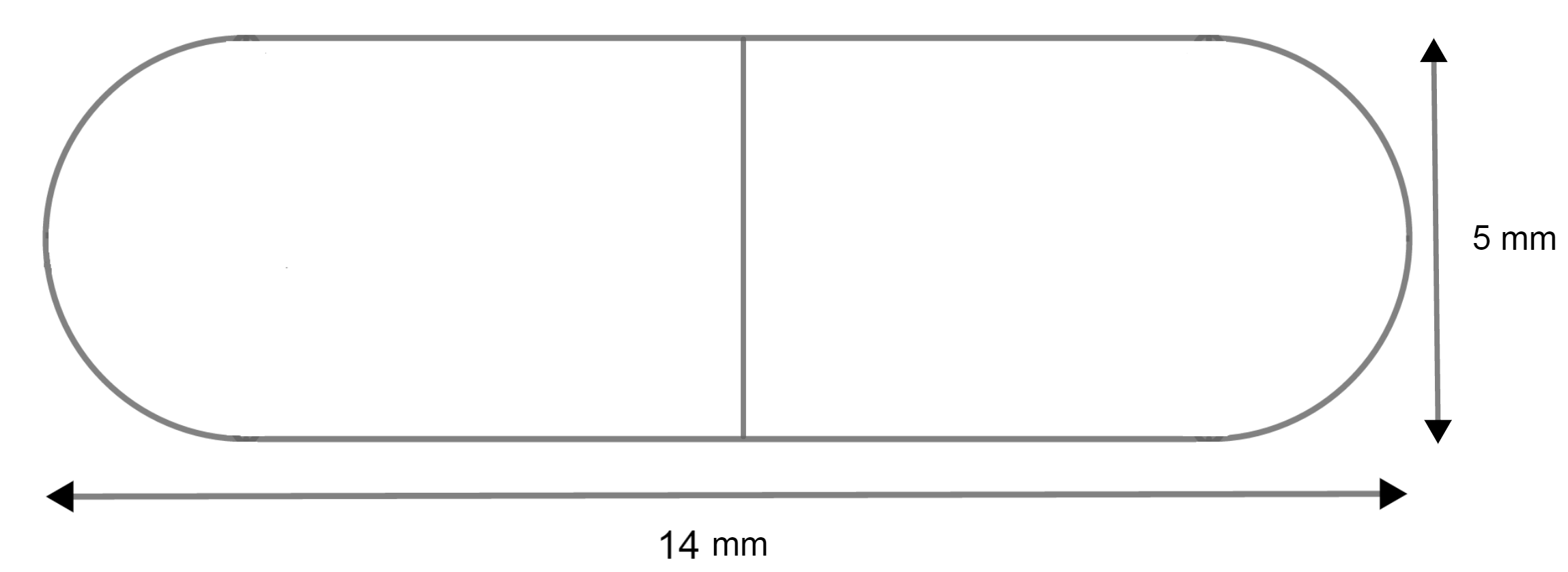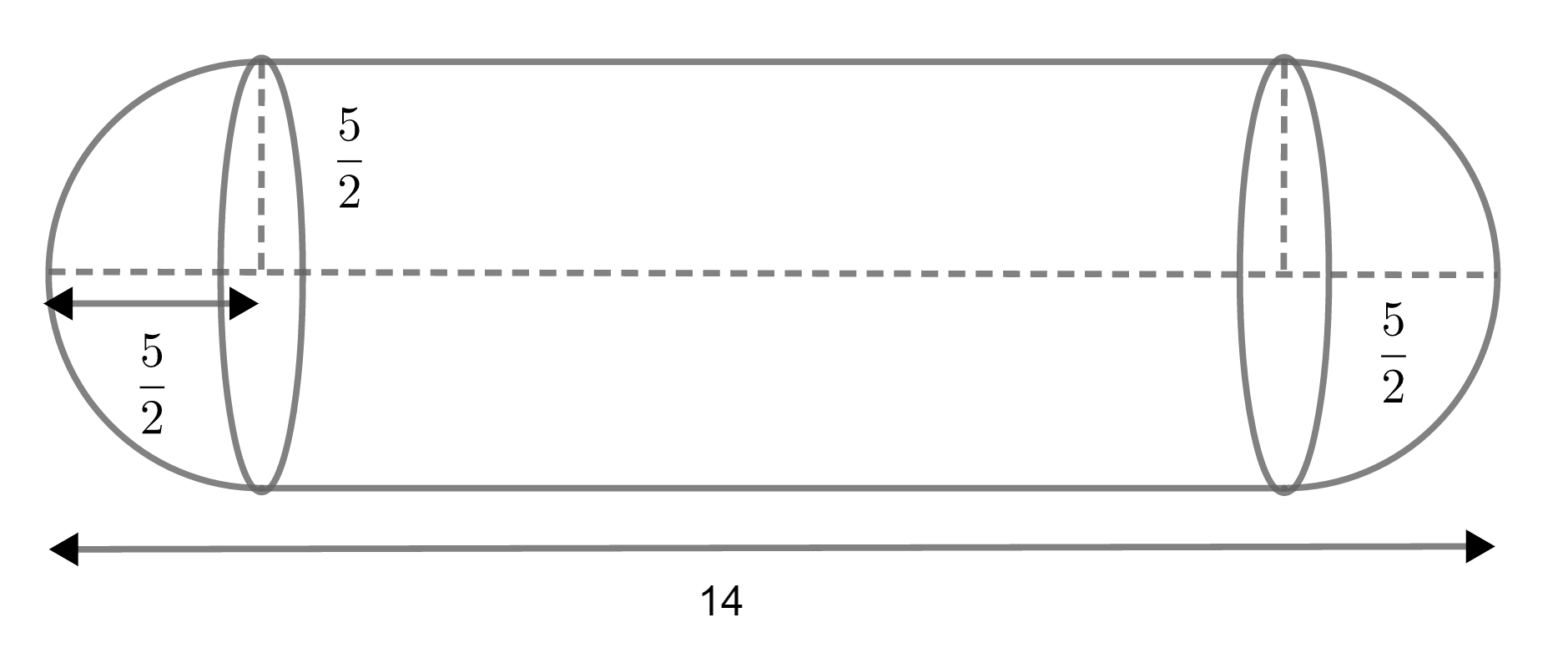
A medicine capsule is in the shape of a cylinder with two hemispheres stuck to each of its ends. The length of the entire capsule is 14mm and the diameter of the capsule is 5mm. Find its surface area.


Answer
509.9k+ views
Hint: At first, try to find out the curved surface area of each of the hemispheres and the cylinder. The formula for calculating curved surface area of cylinder is \[2\pi rh\] and that of hemisphere is \[2\pi {{r}^{2}}\] where, r is the radius of the base and h is the height of cylinder.
Complete step-by-step answer:
In the question, we are given a capsule structure of a capsule with a cylinder in between the two hemispheres. The length of the entire capsule is 14 and the diameter length is 5mm. So, from this we have to find the entire surface area of the capsule.
The figure of the capsule is,

Now, to find the curved surface area, we have to find the curved surface area of each of the cylinder and two hemispheres and add them all.
Now, as we are said that, diameter is 5mm then, the radius will be \[\dfrac{5mm}{2}\] as diameter is twice the radius. As the base is shared by both the hemispheres and the cylinder, so, we can say that the radius of the base of the cylinder and that of hemisphere is \[\dfrac{5}{2}mm\].
The total height of the capsule is given as 14mm in which height of hemisphere is also included which is \[\dfrac{5}{2}mm\] . As there were two hemispheres, hence we can say that, total height of two hemisphere are \[\dfrac{5}{2}mm+\dfrac{5}{2}mm\Rightarrow 5mm\].
So, the height of cylinder is \[14mm-5mm\Rightarrow 9mm\]
Now, at first, we will find the curved surface area of the cylinder using formula \[2\pi rh\] where radius is r, h is the height. Hence, on substituting \[r\text{ as }\dfrac{5}{2}mm\text{ and height as 9mm}\] we get,
\[2\pi \times \dfrac{5}{2}mm\times 9mm\Rightarrow \left( 45\pi \right)m{{m}^{2}}\]
For the hemisphere, we will first find a curved surface of 1 and then we will multiply it by 2, to get the total curved surface area of two hemispheres. We can find curved surface area using formula \[2\pi {{r}^{2}}\] So, for two it will be \[2\times 2\pi {{r}^{2}}\Rightarrow 4\pi {{r}^{2}}\] Here, value of \[r\text{ is }\dfrac{5}{2}mm\] Thus, on substituting we get, \[4\times \pi \times \dfrac{5}{2}mm\times \dfrac{5}{2}mm\Rightarrow \left( 25\pi \right)m{{m}^{2}}\]
Now, hence, on adding the area we get,
\[\left( 45\pi +25\pi \right)m{{m}^{2}}\Rightarrow 70\pi m{{m}^{2}}\]
We know that, the value of \[\pi \text{ is }\dfrac{22}{7}\] so, on substituting we get,
\[\left( 70\times \dfrac{22}{7} \right)m{{m}^{2}}\Rightarrow 220m{{m}^{2}}\]
Thus, the surface area is \[220m{{m}^{2}}\]
Note: Students while solving the problem will tend to do the mistake by calculating total surface area of each of the hemispheres using formula \[3\pi {{r}^{2}}\] and cylinder using \[2\pi r\left( r+h \right)\] separately and add. So, be careful about that.
Complete step-by-step answer:
In the question, we are given a capsule structure of a capsule with a cylinder in between the two hemispheres. The length of the entire capsule is 14 and the diameter length is 5mm. So, from this we have to find the entire surface area of the capsule.
The figure of the capsule is,

Now, to find the curved surface area, we have to find the curved surface area of each of the cylinder and two hemispheres and add them all.
Now, as we are said that, diameter is 5mm then, the radius will be \[\dfrac{5mm}{2}\] as diameter is twice the radius. As the base is shared by both the hemispheres and the cylinder, so, we can say that the radius of the base of the cylinder and that of hemisphere is \[\dfrac{5}{2}mm\].
The total height of the capsule is given as 14mm in which height of hemisphere is also included which is \[\dfrac{5}{2}mm\] . As there were two hemispheres, hence we can say that, total height of two hemisphere are \[\dfrac{5}{2}mm+\dfrac{5}{2}mm\Rightarrow 5mm\].
So, the height of cylinder is \[14mm-5mm\Rightarrow 9mm\]
Now, at first, we will find the curved surface area of the cylinder using formula \[2\pi rh\] where radius is r, h is the height. Hence, on substituting \[r\text{ as }\dfrac{5}{2}mm\text{ and height as 9mm}\] we get,
\[2\pi \times \dfrac{5}{2}mm\times 9mm\Rightarrow \left( 45\pi \right)m{{m}^{2}}\]
For the hemisphere, we will first find a curved surface of 1 and then we will multiply it by 2, to get the total curved surface area of two hemispheres. We can find curved surface area using formula \[2\pi {{r}^{2}}\] So, for two it will be \[2\times 2\pi {{r}^{2}}\Rightarrow 4\pi {{r}^{2}}\] Here, value of \[r\text{ is }\dfrac{5}{2}mm\] Thus, on substituting we get, \[4\times \pi \times \dfrac{5}{2}mm\times \dfrac{5}{2}mm\Rightarrow \left( 25\pi \right)m{{m}^{2}}\]
Now, hence, on adding the area we get,
\[\left( 45\pi +25\pi \right)m{{m}^{2}}\Rightarrow 70\pi m{{m}^{2}}\]
We know that, the value of \[\pi \text{ is }\dfrac{22}{7}\] so, on substituting we get,
\[\left( 70\times \dfrac{22}{7} \right)m{{m}^{2}}\Rightarrow 220m{{m}^{2}}\]
Thus, the surface area is \[220m{{m}^{2}}\]
Note: Students while solving the problem will tend to do the mistake by calculating total surface area of each of the hemispheres using formula \[3\pi {{r}^{2}}\] and cylinder using \[2\pi r\left( r+h \right)\] separately and add. So, be careful about that.
Recently Updated Pages
What happens to glucose which enters nephron along class 10 biology CBSE

Write a dialogue with at least ten utterances between class 10 english CBSE

A circle is inscribed in an equilateral triangle and class 10 maths CBSE

When the JanmiKudian Act was passed that granted the class 10 social science CBSE

A sector containing an angle of 120 circ is cut off class 10 maths CBSE

The sum of digits of a two digit number is 13 If t-class-10-maths-ICSE

Trending doubts
Why is there a time difference of about 5 hours between class 10 social science CBSE

Write a letter to the principal requesting him to grant class 10 english CBSE

What is the median of the first 10 natural numbers class 10 maths CBSE

The Equation xxx + 2 is Satisfied when x is Equal to Class 10 Maths

State and prove converse of BPT Basic Proportionality class 10 maths CBSE

Discuss the main reasons for poverty in India




